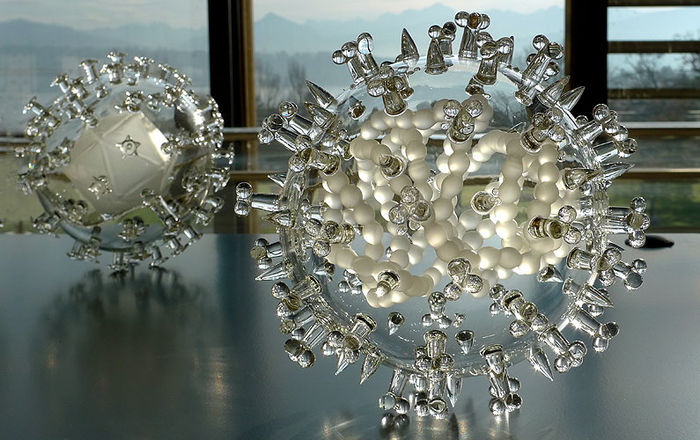“The key to the highest truths”: Primo Levi and the beauty of chemistry
Nathanael Smalley reflects on the life and writing of Primo Levi, and his own experiences as a Natural Sciences student.
Content Note: This article contains discussion of Levi’s imprisonment in Auschwitz.
Primo Levi wasn’t a great scientist. There are no chemical reactions named after him; he published no ground-breaking papers; he made no revolutionary contributions to the paint and lacquer industry. However, through his book, The Periodic Table, Levi contributed something unique to the scientific community.
First published in Italian in 1975, The Periodic Table consists of 21 chapters, each the name of a chemical element and a story (in roughly chronological order) somehow connected to it. Levi was a chemist, graduating from the University of Turin in 1941 under Mussolini’s Fascist government and racial laws. Soon after the collapse of the regime on 25th July 1943 came the Nazi occupation only a few months later on 5th September. Fleeing the occupation, Levi and his peers joined an ill-equipped partisan group in Piedmont. However, he was soon captured and deported to Auschwitz, where he was imprisoned until the end of the war. Finally, after a lengthy journey through Europe, Levi returned to Italy as an industrial chemist.
“The Periodic Table is much more than simply an autobiography; in fact, Levi asserts that it is not that.”
Throughout the book, Levi speaks both openly and eloquently about his life. In the second chapter, Hydrogen, Levi remembers experimenting in a back-yard laboratory. Indeed, which NatSci hasn’t pursued, naïvely or not, to “dredge the bowels of the mystery with our strength, our talent…”, or to “watch the buds swell in spring, the mica glint in the granite, my own hands…[and to say] “I will understand this, too, I will understand everything, but not the way they want me to?”.” And then, at University, to have these dreams of omniscience frustrated when “chemistry itself…did not answer my questions…Did chemistry theorems exist? No: therefore you had to go further, not be satisfied with the quia, go back to the origins, to mathematics and physics.” Or, as one’s sphere of scientific knowledge becomes more specialised, to observe those academics who have tied their “destiny, indelibly, to bromine or polypropylene, or the -NCO group, or glutamic acid”?
It is Levi’s application of such rich, descriptive language to the otherwise mundane of the scientific world which makes this book special. “Distilling is beautiful”, states Levi in Potassium. “When you set about distilling, you acquire the consciousness of repeating a ritual consecrated by the centuries, almost a religious act, from which imperfect material you obtain the essence, the usia, the spirit…” Levi’s understanding of chemistry’s beauty is found throughout the book: whether it be the “pretty structure” of alloxan in Nitrogen, or his rich description of phosphorus as “not an emotionally neutral element”. It was van Gogh himself who noted that “if you truly love nature, you will find beauty everywhere.” Levi seems to have understood this to an intimate degree.
“If Levi were to observe us in these practical classes, complete with our rash deductions, amateurish mistakes and shattered glassware, I like to think he would be pleased.”
Despite this, The Periodic Table is much more than simply an autobiography; in fact, Levi asserts that it is not that. In 2006, the Royal Institution voted it the best science book ever written from a shortlist including works by Konrad Lenz and Berthold Brecht, but it is more than that too. Any first-year biologist would have no problem in pointing out some of the dodgy science in the final chapter, Carbon, which is nevertheless Levi’s tour de force of a literary description of the Calvin Cycle of photosynthesis. Neither is it a moralistic, Aesopian collection of tales and musings, nor a mere anthropomorphism of the elements and their characteristics. Instead, Levi refers to his creation as “in some fashion a history…of a trade and its defeats, victories and miseries, such as everyone wants to tell when he feels close to concluding the arc of his career.” Levi’s compelling grasp of humanity is what shines through the pages: no character is a hero nor a villain, not even Dr. Müller, his boss at the Buna Rubber factory at Auschwitz. After all, for Levi, “reality is always more complex than invention…it rarely lies on one level.”
Yet when reading The Periodic Table, it’s hard not to reflect on its powerful lessons and warnings. Levi’s Judaism is deeply personal: from the chapter Argon, detailing his “inert” Piedmontese Jewish relatives, to the chapter Cerium, detailing his exploits in making contraband lighter flints in Auschwitz. Levi speaks of his pride in being “impure,” drawing the allusion to the unreactivity of pure zinc to acid and the need for a drop of copper sulfate to begin the reaction: “In order for the wheel to turn, for life to be lived, impurities are needed: Fascism does not want them, forbids them, and that’s why you’re not a Fascist; it wants everybody to be the same, and you are not.”
From my own experience, I found myself somewhat dismayed to be handed back my first biological essay to discover that florid language had no place in scientific writing: one friend was rebuked for using the word “created” in an essay, lest it be implied that this particular metabolic reaction was in fact achieved by some sort of divine intervention. “Precise and concise”, our first-year supervisor told us. And yet, Levi’s style could not be further removed from the starchy text of academic journals and scientific essays, describing his trade as “brutally incompatible with writing.” In fact, as a chemist, it is rare that I ever have the chance to read a “proper” book; truthfully, I seldom have an attention span greater than a couple of pages of the “Green Bible” of Organic Chemistry.
Nonetheless, reading Levi’s writing over lockdown, I was reminded that he also witnessed chemistry’s most detestable side at Auschwitz, as part of the Chemical Kommando transporting magnesium chloride, and at the IG-Farben laboratory. Despite this, Levi never lost sight of the beauty of chemistry: for me, found in the sublimation of brilliant emerald-green crystals of nickelocene; in the jagged, imperfect trace of an action potential on the electromyograph; in the faint rainbow of lines emitted by potassium under a sodium discharge lamp. If Levi were to observe us in these practical classes, complete with our rash deductions, amateurish mistakes and shattered glassware, I like to think he would be pleased.
 Interviews / You don’t need to peak at Cambridge, says Robin Harding31 December 2025
Interviews / You don’t need to peak at Cambridge, says Robin Harding31 December 2025 Comment / What happened to men at Cambridge?31 December 2025
Comment / What happened to men at Cambridge?31 December 2025 News / Unions protest handling of redundancies at Epidemiology Unit30 December 2025
News / Unions protest handling of redundancies at Epidemiology Unit30 December 2025 News / Varsity’s biggest stories of 202531 December 2025
News / Varsity’s biggest stories of 202531 December 2025 News / Downing investigates ‘mysterious’ underground burial vault 29 December 2025
News / Downing investigates ‘mysterious’ underground burial vault 29 December 2025










